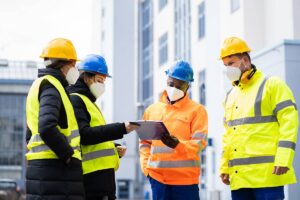Recently, the Occupational Safety and Health Administration (OSHA) announced its new National Emphasis Program (NEP).
The NEP focuses enforcement efforts on companies that put the highest amount of workers at risk for contracting COVID-19. Generally, most OSHA inspections include an opening conference, document review and witness interviews, a walk through the facility, and a closing conference. The NEP has specific parameters and guidelines on each part of the COVID-19 inspection.
How to Prepare for a COVID-19 Inspection
Here are five steps employers should take to prepare for a potential COVID-19 inspection.
- Create a Written COVID-19 Policy – The first step OSHA will take when they arrive for an inspection under the NEP will be to ask for your written COVID-19 protocols and response plan. A good starting point is the model Virginia COVID-19 response plan — use it to prepare your federal COVID-19 plan.
- Train Employees on COVID-19 Policies – Having formalized your policies into a written plan with step one will make training employees easier and more effective. OSHA’s will inquire on how your protocols have been communicated to employees. In addition to sharing your written policy, communicate with employees on the measures you have taken to keep them safe. This will help with handling an inspection as well as ease concerns your workers may have about potential exposure.
- Always Keep Your Workplace Clean and Disinfected – How your workplace looks during an inspection can shape the way an inspection goes. Inspectors will be looking for clean surfaces, sanitation stations, and overall good housekeeping. Ensure that commonly touched surfaces such as door knobs, light switches, buttons, restrooms, and break rooms are frequently cleaned and sanitized. If you are using powerful chemicals and cleaning products, ensure workers are trained on the hazards.
- Practice Social Distancing – If your employees are not practicing social distancing, it will be one of the first things inspectors notice. Encourage physical distancing of six feet when possible. The CDC has recommended staggering shift start times, lunch breaks, and other times when employees will be in your facility. Mark hallways with direction arrows and create “one way” walk zones to limit “head-on” traffic. Also, work to increase the number of HVAC air exchanges at your facility and install air filters where possible.
- Ensure the OSHA Inspector is Safe – Be sure to provide the inspector with the correct personal protective equipment before the inspection begins. Give them a quick training session on your COVID-19 safety protocols. This will impress the inspector and help keep them safe throughout the visit. Employers and inspectors should share the common goal of keeping employees safe, and showing this will build rapport during the inspection.
Under the NEP, OSHA is pushing to conduct additional COVID-19 inspections in the upcoming months.
Take these steps now, and you’ll be well-prepared for a COVID-19 inspection.
**
About Worksite Medical
In most cases, OSHA requires medical surveillance testing, and at no cost to employees.
Worksite Medical makes that program easier with mobile medical testing.
We conduct on-site respirator fit tests, as well as audiometric exams, pulmonary function tests and heavy metal lab work, right on your job site. We also keep accurate, easy-to-access medical records for your convenience. You’ll keep your employees at work, and stay ahead of OSHA inspections.
With Worksite Medical, a mobile medical testing unit — we can bring all the resources of a lab to you. Our certified lab technicians can perform both qualitative and quantitative respirator tests to ensure a perfect fit.
Protect your team and your workplace now with Worksite Medical. Not sure what you need? Try our medical testing wizard here.
Give us a call at 1-844-622-8633, or complete the form below to schedule an on-site visit or to get your free quote.




